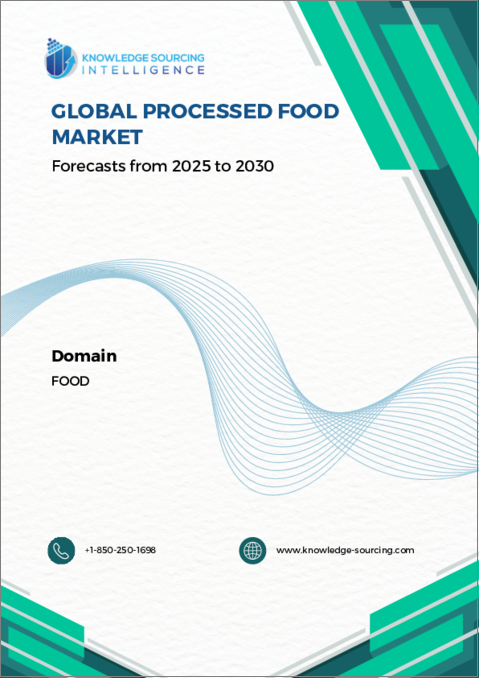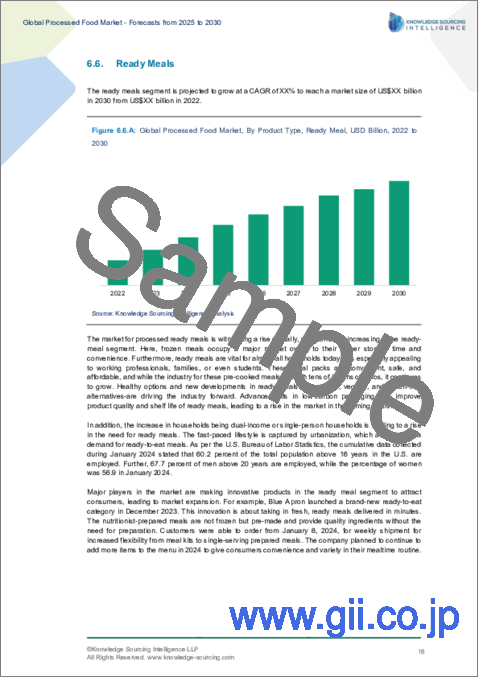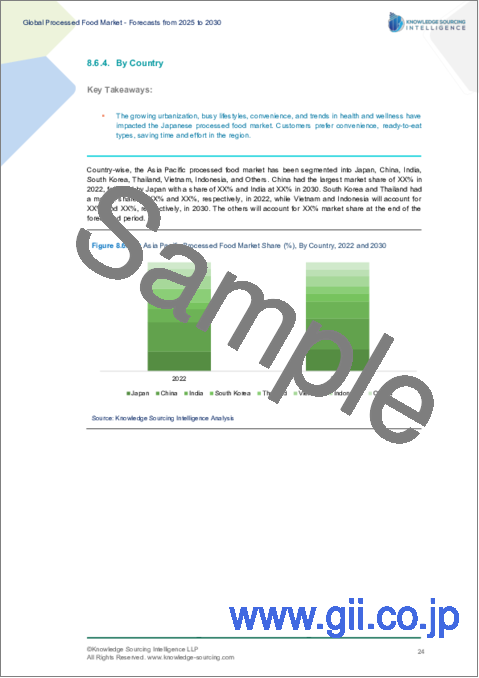|
|
市場調査レポート
商品コード
1649417
世界の加工食品市場-2025年から2030年までの予測Global Processed Food Market - Forecasts from 2025 to 2030 |
||||||
カスタマイズ可能
|
|||||||
| 世界の加工食品市場-2025年から2030年までの予測 |
|
出版日: 2025年01月03日
発行: Knowledge Sourcing Intelligence
ページ情報: 英文 140 Pages
納期: 即日から翌営業日
|
全表示
- 概要
- 目次
世界の加工食品市場はCAGR 4.45%で成長し、2025年の2兆1,577億6,100万米ドルから2030年には2兆6,831億6,400万米ドルになると予測されています。
加工食品とは、調理、冷凍、缶詰、または保存期間、風味、利便性を高めるための保存料やその他の成分の添加といった方法を通じて、自然の状態から変化させた食品を指します。冷凍野菜やカット済み果物のような最小限の加工を施したものから、缶入りスープ、パック入りスナック菓子、砂糖入り飲料のような大量の加工を施したものまで、さまざまな食品があります。超加工食品には、人工添加物や保存料が多数含まれていることが多く、原材料がほとんど存在しないほど精製されています。加工食品は便利であることが主な利点ですが、一般に栄養価が低く、食べ過ぎると肥満や心臓関連の問題を引き起こす可能性があります。
世界の加工食品市場の主な促進要因:
- 利便性への要求の高まり:消費者の多忙化に伴い、手早く簡単に調理できる便利な食事ソリューションへの需要が高まっています。都市化、食品加工技術の進歩、パッケージングの革新、ライフスタイルの変化などが、より手頃な価格で入手しやすく日持ちのする加工食品の台頭に寄与しています。加えて、可処分所得の増加と、すぐに食べられるものや持ち運び可能なものへの嗜好が、引き続き市場の成長を後押ししています。加工食品が提供する多様性と風味は、食品ブランドの世界化と相まって、その魅力を世界的にさらに拡大させています。
- 缶詰・冷凍方法の人気の高まり:必須ビタミンとミネラルが豊富で保存性の高い高品質の食品を消費することにより、健康的なライフスタイルを送ることを意識する個人が増えています。この動向は、都市部の人々に手軽で便利な食品を好むよう促しています。消費力の増大も、さまざまな缶詰食品の人気を押し上げ、食品加工における缶詰技術の需要を高めています。
さらに、多忙な専門家が1週間先の食事を準備するのに伴い、冷凍加工が人気を集めています。冷凍された果物や野菜は、繊細なビタミンや栄養素を保ちながら鮮度を長く保つことができるため、時間が限られている人々にとって魅力的な選択肢となっています。
加工食品市場の地理的展望:
- 世界のセグメンテーション:世界の加工食品市場は、北米、南米、欧州、中東・アフリカ、アジア太平洋の5地域に区分されます。
- 北米:この地域は、加工食品の高度な品種を提供する企業の増加により、予測期間中に大きなシェアを占めると予想されます。
- アジア太平洋:アジア太平洋地域は、各国政府が食品・飲料セクターを強化するためのイニシアチブを実施しているため、予測期間中に市場シェアが大幅に拡大すると予測されます。例えば、インドの食品加工市場規模は、可処分所得の増加と都市化の進展に伴う消費者基盤の拡大により、2022年の8,660億米ドルから2027年には1兆2,740億米ドルに達すると予測されます。
インド食品安全基準局(FSSAI)のような当局による厳しい規制は、インドなどで販売される食品や飲食品の安全性を保証しています。さらに、インド、中国、日本を含むこの地域のさまざまな国々で、肉と魚介類の消費が顕著に増加しています。
- 洞察に満ちた分析:顧客セグメント、政府政策と社会経済要因、消費者の嗜好、産業別、その他のサブセグメントに焦点を当て、主要地域だけでなく新興地域もカバーする詳細な市場考察を得ることができます。
- 競合情勢:世界の主要企業が採用している戦略的作戦を理解し、適切な戦略による市場浸透の可能性を理解することができます。
- 市場動向と促進要因:ダイナミックな要因と極めて重要な市場動向、そしてそれらが今後の市場展開をどのように形成していくかを探ります。
- 実行可能な提言:ダイナミックな環境の中で新たなビジネスストリームと収益を発掘するための戦略的決断を下すために、洞察を活用します。
- 幅広い利用者に対応:新興企業、研究機関、コンサルタント、中小企業、大企業にとって有益で費用対効果の高いです。
どのような用途で利用されていますか?
業界および市場考察、事業機会評価、製品需要予測、市場参入戦略、地理的拡大、設備投資の決定、規制の枠組みと影響、新製品開拓、競合の影響
調査範囲
- 2022年から2030年までの過去データ&予測
- 成長機会、課題、サプライチェーンの展望、規制枠組み、顧客行動、およびトレンド分析
- 競合のポジショニング、戦略、および市場シェア分析
- 収益の成長と予測国々を含むセグメントおよび地域の分析
- 企業プロファイリング(特に主な動向など)
世界の加工食品市場は以下のようにセグメント分けされています:
加工方法別
- 冷凍
- 乾燥
- 缶詰
- 焼成
製品タイプ別
- 朝食用シリアル
- チーズ・乳製品
- 缶詰野菜・果物
- 肉製品
- レディミール
- ケーキ・ビスケット
- その他
流通チャネル別
- オンライン
- オフライン
地域別
- 北米
- 米国
- カナダ
- メキシコ
- 南米
- ブラジル
- アルゼンチン
- その他南米
- 欧州
- 英国
- ドイツ
- フランス
- イタリア
- スペイン
- その他南米
- 中東・アフリカ
- サウジアラビア
- UAE
- その他中東・アフリカ
- アジア太平洋地域
- 中国
- インド
- 日本
- 韓国
- 台湾
- タイ
- インドネシア
- その他アジア太平洋地域
目次
第1章 イントロダクション
- 市場概要
- 市場の定義
- 調査範囲
- 市場セグメンテーション
- 通貨
- 前提条件
- 基準年と予測年のタイムライン
- 利害関係者にとっての主なメリット
第2章 調査手法
- 調査デザイン
- 調査プロセス
第3章 エグゼクティブサマリー
- 主な調査結果
- アナリストビュー
第4章 市場力学
- 市場促進要因
- 市場抑制要因
- ポーターのファイブフォース分析
- 業界バリューチェーン分析
第5章 世界の加工食品市場:加工方法別
- イントロダクション
- 冷凍
- 乾燥
- 缶詰
- 焼成
第6章 世界の加工食品市場:製品タイプ別
- イントロダクション
- 朝食用シリアル
- チーズ・乳製品
- 缶詰野菜・果物
- 肉製品
- レディミール
- ケーキ・ビスケット
- その他
第7章 世界の加工食品市場:流通チャネル別
- イントロダクション
- オンライン
- オフライン
第8章 世界の加工食品市場:地域別
- 世界概要
- 北米
- 米国
- カナダ
- メキシコ
- 南米
- ブラジル
- アルゼンチン
- その他南米
- 欧州
- 英国
- ドイツ
- フランス
- イタリア
- スペイン
- その他欧州地域
- 中東・アフリカ
- サウジアラビア
- アラブ首長国連邦
- その他中東・アフリカ
- アジア太平洋地域
- 中国
- インド
- 日本
- 韓国
- 台湾
- タイ
- インドネシア
- その他アジア太平洋地域
第9章 競合環境と分析
- 主要企業と戦略分析
- 市場シェア分析
- 合併、買収、合意およびコラボレーション
- 競合ダッシュボード
第10章 企業プロファイル
- Unilever
- Nestle SA
- The Kraft Heinz Company
- The J.M. Smucker Company
- CSC BRANDS, L.P.
- ADM
- Tyson Foods, Inc.
- Kellogg NA Co.
- Conagra Brands, Inc.
- Hormel Foods Corporation
The global processed food market is projected to grow at a CAGR of 4.45%, from US$2,157.761 billion in 2025 to US$2,683.164 billion in 2030.
Processed food refers to food that has been modified from its natural state through methods such as cooking, freezing, canning, or the addition of preservatives and other ingredients to enhance shelf life, flavor, or convenience. These foods range from minimally processed items like frozen vegetables and pre-cut fruits to heavily processed products such as canned soups, packaged snacks, and sugary beverages. Ultra-processed foods often contain numerous artificial additives and preservatives, making them so refined that whole ingredients are barely present. While convenience is a key benefit, processed foods generally provide lower nutritional value and can contribute to obesity and heart-related issues if consumed in excess.
Key Drivers of the Global Processed Food Market:
- Growing Demand for Convenience: The increasing busyness of consumers has led to a higher demand for convenient meal solutions that are quick and easy to prepare. Urbanization, advancements in food processing technology, innovations in packaging, and changing lifestyles are all contributing to the rise of processed foods that are more affordable, accessible, and long-lasting. Additionally, higher disposable incomes and a preference for ready-to-eat or on-the-go options continue to drive market growth. The variety and flavor offered by processed foods, coupled with the globalization of food brands, have further expanded their appeal worldwide.
- Rising Popularity of Canning and Freezing Methods: More individuals are becoming conscious of leading healthy lifestyles by consuming high-quality foods rich in essential vitamins and minerals that also have good shelf lives. This trend is prompting urban populations to favor easy and convenient food options. Increased spending power is also boosting the popularity of various canned foods and enhancing the demand for canning techniques in food processing.
Furthermore, frozen processing is gaining traction as busy professionals prepare meals for the week ahead. Frozen fruits and vegetables remain fresh longer while preserving sensitive vitamins and nutrients, making them an attractive option for those with limited time.
Geographical Outlook of the Processed Food Market:
- Global Segmentation: The global processed food market is divided into five regions: North America, South America, Europe, the Middle East and Africa, and Asia Pacific.
- North America: This region is expected to hold a significant share during the forecast period due to an increasing number of companies offering advanced varieties of processed foods. Additionally, there are rising investments in research and development aimed at improving processing techniques and equipment within the established food and beverage sector.
- Asia Pacific: The Asia Pacific region is projected to experience substantial growth in market share over the forecast period as governments implement initiatives to bolster the food and beverage sector. For example, India's food processing market size is anticipated to reach US$1,274 billion by 2027, up from US$866 billion in 2022, driven by a growing consumer base with rising disposable incomes and increasing urbanization.
Strict regulations from authorities like the Food Safety and Standards Authority of India (FSSAI) ensure the safety of foods and beverages sold in countries such as India. Additionally, there is a notable increase in meat and seafood consumption across various countries in this region, including India, China, and Japan.Reasons for buying this report:-
- Insightful Analysis: Gain detailed market insights covering major as well as emerging geographical regions, focusing on customer segments, government policies and socio-economic factors, consumer preferences, industry verticals, other sub- segments.
- Competitive Landscape: Understand the strategic maneuvers employed by key players globally to understand possible market penetration with the correct strategy.
- Market Drivers & Future Trends: Explore the dynamic factors and pivotal market trends and how they will shape up future market developments.
- Actionable Recommendations: Utilize the insights to exercise strategic decision to uncover new business streams and revenues in a dynamic environment.
- Caters to a Wide Audience: Beneficial and cost-effective for startups, research institutions, consultants, SMEs, and large enterprises.
What do businesses use our reports for?
Industry and Market Insights, Opportunity Assessment, Product Demand Forecasting, Market Entry Strategy, Geographical Expansion, Capital Investment Decisions, Regulatory Framework & Implications, New Product Development, Competitive Intelligence
Report Coverage:
- Historical data & forecasts from 2022 to 2030
- Growth Opportunities, Challenges, Supply Chain Outlook, Regulatory Framework, Customer Behaviour, and Trend Analysis
- Competitive Positioning, Strategies, and Market Share Analysis
- Revenue Growth and Forecast Assessment of segments and regions including countries
- Company Profiling (Strategies, Products, Financial Information, and Key Developments among others)
The Global Processed Food Market has been segmented as following:
By Processing Method
- Freezing
- Drying
- Canning
- Baking
By Product Type
- Breakfast Cereals
- Cheese and Dairy
- Canned Vegetables and Fruits
- Meat Products
- Ready Meals
- Cakes And Biscuits
- Others
By Distribution Channel
- Online
- Offline
By Geography
- North America
- USA
- Canada
- Mexico
- South America
- Brazil
- Argentina
- Rest of South America
- Europe
- United Kingdom
- Germany
- France
- Italy
- Spain
- Rest of Europe
- Middle East and Africa
- Saudi Arabia
- UAE
- Rest of the Middle East and Africa
- Asia Pacific
- China
- India
- Japan
- South Korea
- Taiwan
- Thailand
- Indonesia
- Rest of Asia-Pacific
TABLE OF CONTENTS
1. INTRODUCTION
- 1.1. Market Overview
- 1.2. Market Definition
- 1.3. Scope of the Study
- 1.4. Market Segmentation
- 1.5. Currency
- 1.6. Assumptions
- 1.7. Base and Forecast Years Timeline
- 1.8. Key benefits for the stakeholders
2. RESEARCH METHODOLOGY
- 2.1. Research Design
- 2.2. Research Process
3. EXECUTIVE SUMMARY
- 3.1. Key Findings
- 3.2. Analyst View
4. MARKET DYNAMICS
- 4.1. Market Drivers
- 4.2. Market Restraints
- 4.3. Porter's Five Forces Analysis
- 4.3.1. Bargaining Power of Suppliers
- 4.3.2. Bargaining Power of Buyers
- 4.3.3. The Threat of New Entrants
- 4.3.4. Threat of Substitutes
- 4.3.5. Competitive Rivalry in the Industry
- 4.4. Industry Value Chain Analysis
5. GLOBAL PROCESSED FOOD MARKET BY PROCESSING METHOD
- 5.1. Introduction
- 5.2. Freezing
- 5.3. Drying
- 5.4. Canning
- 5.5. Baking
6. GLOBAL PROCESSED FOOD MARKET BY PRODUCT TYPE
- 6.1. Introduction
- 6.2. Breakfast Cereals
- 6.3. Cheese and Dairy
- 6.4. Canned Vegetables and Fruits
- 6.5. Meat Products
- 6.6. Ready Meals
- 6.7. Cakes And Biscuits
- 6.8. Others
7. GLOBAL PROCESSED FOOD MARKET BY DISTRIBUTION CHANNEL
- 7.1. Introduction
- 7.2. Online
- 7.3. Offline
8. GLOBAL PROCESSED FOOD MARKET BY GEOGRAPHY
- 8.1. Global Overview
- 8.2. North America
- 8.2.1. United States
- 8.2.2. Canada
- 8.2.3. Mexico
- 8.3. South America
- 8.3.1. Brazil
- 8.3.2. Argentina
- 8.3.3. Rest of South America
- 8.4. Europe
- 8.4.1. United Kingdom
- 8.4.2. Germany
- 8.4.3. France
- 8.4.4. Italy
- 8.4.5. Spain
- 8.4.6. Rest of Europe
- 8.5. Middle East and Africa
- 8.5.1. Saudi Arabia
- 8.5.2. United Arab Emirates
- 8.5.3. Rest of the Middle East and Africa
- 8.6. Asia-Pacific
- 8.6.1. China
- 8.6.2. India
- 8.6.3. Japan
- 8.6.4. South Korea
- 8.6.5. Taiwan
- 8.6.6. Thailand
- 8.6.7. Indonesia
- 8.6.8. Rest of Asia-Pacific
9. COMPETITIVE ENVIRONMENT AND ANALYSIS
- 9.1. Major Players and Strategy Analysis
- 9.2. Market Share Analysis
- 9.3. Mergers, Acquisitions, Agreements, and Collaborations
- 9.4. Competitive Dashboard
10. COMPANY PROFILES
- 10.1. Unilever
- 10.2. Nestle SA
- 10.3. The Kraft Heinz Company
- 10.4. The J.M. Smucker Company
- 10.5. CSC BRANDS, L.P.
- 10.6. ADM
- 10.7. Tyson Foods, Inc.
- 10.8. Kellogg NA Co.
- 10.9. Conagra Brands, Inc.
- 10.10. Hormel Foods Corporation






